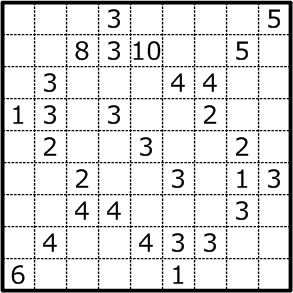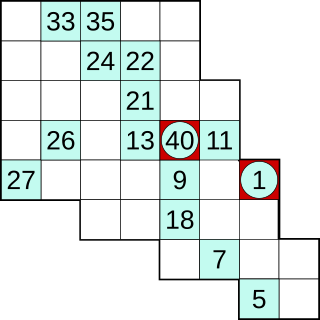
Nonograms, also known as Hanjie, Paint by Numbers, Picross, Griddlers, and Pic-a-Pix, and by various other names, are picture logic puzzles in which cells in a grid must be colored or left blank according to numbers at the side of the grid to reveal a hidden picture. In this puzzle type, the numbers are a form of discrete tomography that measures how many unbroken lines of filled-in squares there are in any given row or column. For example, a clue of "4 8 3" would mean there are sets of four, eight, and three filled squares, in that order, with at least one blank square between successive sets.

Kakuro or Kakkuro or Kakoro is a kind of logic puzzle that is often referred to as a mathematical transliteration of the crossword. Kakuro puzzles are regular features in many math-and-logic puzzle publications across the world. In 1966, Canadian Jacob E. Funk, an employee of Dell Magazines, came up with the original English name Cross Sums and other names such as Cross Addition have also been used, but the Japanese name Kakuro, abbreviation of Japanese kasan kurosu, seems to have gained general acceptance and the puzzles appear to be titled this way now in most publications. The popularity of Kakuro in Japan is immense, second only to Sudoku among Nikoli's famed logic-puzzle offerings.

Sudoku is a logic-based, combinatorial number-placement puzzle. In classic sudoku, the objective is to fill a 9 × 9 grid with digits so that each column, each row, and each of the nine 3 × 3 subgrids that compose the grid contain all of the digits from 1 to 9. The puzzle setter provides a partially completed grid, which for a well-posed puzzle has a single solution.
Nurikabe is a binary determination puzzle named for Nurikabe, an invisible wall in Japanese folklore that blocks roads and delays foot travel. Nurikabe was apparently invented and named by Nikoli; other names for the puzzle include Cell Structure and Islands in the Stream.

Hitori is a type of logic puzzle published by Nikoli.

Fillomino (フィルオミノ) is a type of logic puzzle published by many publishers. Other published titles for the puzzle include Allied Occupation.

Where are the black cells?, abbreviated Kuromasu or Kurodoko, is a binary-determination logic puzzle published by Nikoli. As of 2005, one book consisting entirely of Kuromasu puzzles has been published by Nikoli.

Ripple Effect is a logic puzzle published by Nikoli. As of 2007, two books consisting entirely of Ripple Effect puzzles have been published by Nikoli. The second was published on October 4, 2007.
In mathematics, given a collection of subsets of a set X, an exact cover is a subcollection of such that each element in is contained in exactly one subset in . One says that each element in is covered by exactly one subset in . An exact cover is a kind of cover.

Sudoku puzzles can be studied mathematically to answer questions such as "How many filled Sudoku grids are there?", "What is the minimal number of clues in a valid puzzle?" and "In what ways can Sudoku grids be symmetric?" through the use of combinatorics and group theory.

Killer sudoku is a puzzle that combines elements of sudoku and kakuro. Despite the name, the simpler killer sudokus can be easier to solve than regular sudokus, depending on the solver's skill at mental arithmetic; the hardest ones, however, can take hours to crack.

This is a glossary of Sudoku terms and jargon. It is organized thematically, with links to references and example usage provided as ([1]). Sudoku with a 9×9 grid is assumed, unless otherwise noted.

Inshi no heya is a type of logic puzzle published by Nikoli. It is a specific form of the KenKen puzzle genre where every operation is implied to be multiplication.

A standard Sudoku contains 81 cells, in a 9×9 grid, and has 9 boxes, each box being the intersection of the first, middle, or last 3 rows, and the first, middle, or last 3 columns. Each cell may contain a number from one to nine, and each number can only occur once in each row, column, and box. A Sudoku starts with some cells containing numbers (clues), and the goal is to solve the remaining cells. Proper Sudokus have one solution. Players and investigators use a wide range of computer algorithms to solve Sudokus, study their properties, and make new puzzles, including Sudokus with interesting symmetries and other properties.

Picross DS (ピクロスDS) is a puzzle video game developed by Jupiter and published by Nintendo for the Nintendo DS handheld video game console. It is the second Picross game to be released by Nintendo in Europe and North America after Mario's Picross suffered a commercial failure in regions outside Japan, where many Picross games have been released for several Nintendo consoles. Like other Picross games, it presents the player with a series of nonogram logic puzzles to solve. It was first released in Japan, and was later released in North America, Europe and Australia.
A Survo puzzle is a kind of logic puzzle presented and studied by Seppo Mustonen. The name of the puzzle is associated with Mustonen's Survo system, which is a general environment for statistical computing and related areas.
KenKen and KenDoku are trademarked names for a style of arithmetic and logic puzzle invented in 2004 by Japanese math teacher Tetsuya Miyamoto, who intended the puzzles to be an instruction-free method of training the brain. The name derives from the Japanese word for cleverness. The names Calcudoku and Mathdoku are sometimes used by those who do not have the rights to use the KenKen or KenDoku trademarks.

Hidato, also known as "Hidoku", is a logic puzzle game invented by Dr. Gyora M. Benedek, an Israeli mathematician. The goal of Hidato is to fill the grid with consecutive numbers that connect horizontally, vertically, or diagonally. The name Hidato is a registered trademark of Doo-Bee Toys and Games LTD, a company co-founded by Benebek himself. Some publishers use different names for this puzzle such as Number Snake, Snakepit, Jadium or Numbrix.

Str8ts is a logic-based number-placement puzzle, invented by Jeff Widderich in 2008. It is distinct from, but shares some properties and rules with Sudoku. The name is derived from the poker straight. The puzzle is published in a number of newspapers internationally, in two book collections, and in downloadable apps. It was featured on the Canadian television show Dragons' Den on November 24, 2010.
Takuzu, also known as Binairo, is a logic puzzle involving placement of two symbols, often 1s and 0s, on a rectangular grid. The objective is to fill the grid with 1s and 0s, where there is an equal number of 1s and 0s in each row and column and no more than two of either number adjacent to each other. Additionally, there can be no identical rows or columns. Similar to Sudoku, each puzzle begins with several squares in the grid already filled.












